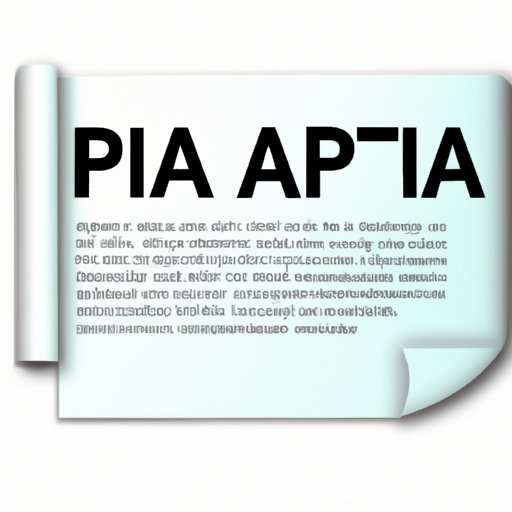
Introduction
Proper citation is an essential element of academic and professional writing. It provides the necessary credit to the original author for their work and sources, and it also ensures that the writer is not accused of plagiarism. APA (American Psychological Association) citation style is one of the most widely used in the social sciences and academic writing. In this article, we will provide a step-by-step guide to doing proper APA in-text citation, highlighting common mistakes to avoid, discussing the importance of proper citation, and offering tips on using citation tools.
Step by Step Guide
The following steps are helpful in creating proper APA in-text citations:
- Start with the author’s surname and year of publication in parentheses.
- If you are citing a direct quote, include the page number in the in-text citation.
- If there are multiple authors, include all of their surnames in the first citation, and then use “et al.” for subsequent citations.
- For sources without an author, use the title of the work and the year of publication.
- If you are citing from a specific chapter or a section of a source, include the chapter or section title and the page number.
Example: (Smith, 2019)
Example: (Smith, 2019, p. 25)
Example: (Johnson, Smith, & Davis, 2018) – (Johnson et al., 2018)
Example: (“The Importance of Proper Citation,” 2020)
Example: (Smith, 2019, “Chapter 3,” p. 41)
Benefits of APA Citation
Proper citation is crucial for several reasons, including:
- Avoiding plagiarism
- Crediting and honoring the original author
- Maintaining an organized, accurate reference list
By using proper APA in-text citation, you can avoid the serious consequences of plagiarism (such as suspension or expulsion from your academic program or legal action), honor and respect the original author and their work, and create a more organized and accurate reference list for your reader(s).
Common Mistakes to Avoid
Some of the most common mistakes people make when doing APA in-text citation include:
- Forgetting to use parentheses
- Not including the year of publication
- Incorrectly formatting multiple author citations
- Not citing direct quotes or borrowed information
- Wrongly citing from sources with no authors listed
To avoid these mistakes, carefully follow the APA in-text citation guidelines, and always double-check your work to ensure that you have cited your sources accurately and completely. Use citation generators and other citation tools to help you streamline the process, avoid errors, and stay organized.
Using Citation Tools
There are several helpful online and offline tools that you can use to generate proper APA in-text citations. Some of the most popular citation tools include:
- Citation Machine: This online platform allows you to create citations in APA format and other styles by simply copying and pasting your sources.
- BibMe: This tool offers free automatic citation generation for various styles, including APA in-text citation.
- Zotero: This free, open-source research tool helps you collect, organize, and cite sources in various formats, including APA.
When using citation tools, always check your work to ensure that the generated citation is accurate and follows the APA guidelines. Citation tools can help save time, but they are not infallible and may make mistakes.
Understanding the Guidelines
It’s important to understand the APA guidelines for citing sources and formatting your paper. Here are some of the key guidelines to keep in mind:
- Use Times New Roman 12-point font and double-spacing throughout your paper.
- Include a title page, abstract (if applicable), and reference list (sorted alphabetically by author’s surname).
- Cite sources in-text using author’s surname and year of publication (and page number for direct quotes).
- Use italics for book titles, journal titles, and other long works.
- Format electronic source citations using the DOI (digital object identifier) or the URL.
- Use hanging indents in your reference list, with the first line of each citation flush with the left-hand margin and subsequent lines indented.
By following these guidelines and familiarizing yourself with the specific APA formatting and citation styles, you can ensure that your work is properly cited, organized, and easy to understand.
Conclusion
Proper APA in-text citation is essential for academic and professional writing. It helps to avoid plagiarism, credit the original author, and maintain an organized, accurate reference list. By following the step-by-step guide provided in this article, using online and offline citation tools, and familiarizing yourself with the APA guidelines, you can create work that is clear, accurate, and properly cited.
For more information, refer to the official APA Publication Manual or consult with your instructor or academic advisor.




